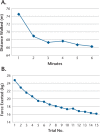Relationship Between Fatigability and Perceived Fatigue Measured Using the Neurological Fatigue Index in People with Multiple Sclerosis
- PMID: 29070963
- PMCID: PMC5649346
- DOI: 10.7224/1537-2073.2016-059
Relationship Between Fatigability and Perceived Fatigue Measured Using the Neurological Fatigue Index in People with Multiple Sclerosis
Abstract
Background: Understanding the relationship between perceived fatigue and performance fatigability could lead to more effective interventions to manage multiple sclerosis (MS)-related fatigue. However, the relationship between self-perceived fatigue measured using the Neurological Fatigue Index (NFI-MS) and performance fatigability in people with MS is unknown. We sought to explore the relationship between the NFI-MS and performance fatigability in people with MS.
Methods: Fifty-two participants (mean ± SD age, 46.8 ± 10.1 years) completed the study. Three measures of performance fatigability were used: percent change in meters walked from first to last minute of the 6-Minute Walk Test, percent change in force exerted from first to last trial on a repetitive maximal hand grip test, and response speed variability on the Continuous Performance Test. Perceived physical and cognitive fatigue were measured using the NFI-MS. The state level of fatigue was examined immediately before and after performing the fatigability measures using a one-item visual analogue fatigue scale.
Results: Of the three performance fatigability measures, only the attentional task (response speed variability) was significantly associated with NFI-MS physical (r = 0.326, P = .020) and cognitive (r = 0.276, P = .050) domain scores. Participants demonstrated significantly higher state levels of fatigue after performing all performance fatigability measures (P ≤ .001).
Conclusions: The NFI-MS and the performance fatigability measures used in this study are easy to administer. We encourage wider use of these measures in clinical and research settings for comprehensive assessment of MS-related fatigue.
Conflict of interest statement
Dr. Bruce provides unbranded talks for the Novartis speakers' bureau and has served on the Novartis MS and Cognition Medical Advisory Board. The other authors have no conflicts of interest to disclose.
Figures


Similar articles
-
The relationship between fatigability and sleep quality in people with multiple sclerosis.Mult Scler J Exp Transl Clin. 2016 Dec 7;2:2055217316682774. doi: 10.1177/2055217316682774. eCollection 2016 Jan-Dec. Mult Scler J Exp Transl Clin. 2016. PMID: 28607747 Free PMC article.
-
The relationship between sleep quality and perceived fatigue measured using the Neurological Fatigue Index in people with Multiple Sclerosis.Neurol Res. 2016 Nov;38(11):943-949. doi: 10.1080/01616412.2016.1232014. Epub 2016 Sep 16. Neurol Res. 2016. PMID: 27638459
-
Predictors of performance and perceived fatigability in people with multiple sclerosis.Neurol Res. 2023 Nov;45(11):994-1002. doi: 10.1080/01616412.2023.2252283. Epub 2023 Sep 1. Neurol Res. 2023. PMID: 37655601
-
Evaluation of fatigability measurement: Integrative review.Geriatr Nurs. 2018 Jan-Feb;39(1):39-47. doi: 10.1016/j.gerinurse.2017.05.014. Epub 2017 Jun 27. Geriatr Nurs. 2018. PMID: 28666548 Free PMC article. Review.
-
Perceived Versus Performance Fatigability in Patients With Rheumatoid Arthritis.Front Physiol. 2018 Oct 10;9:1395. doi: 10.3389/fphys.2018.01395. eCollection 2018. Front Physiol. 2018. PMID: 30364087 Free PMC article. Review.
Cited by
-
Cognitive Fatigue in Multiple Sclerosis: An Objective Approach to Diagnosis and Treatment by Transcranial Electrical Stimulation.Brain Sci. 2019 May 2;9(5):100. doi: 10.3390/brainsci9050100. Brain Sci. 2019. PMID: 31052593 Free PMC article. Review.
-
Work-Related Fatigue: Relationship Between Perceived and Performance Fatigability in Career Firefighters.J Occup Environ Med. 2025 Feb 1;67(2):110-114. doi: 10.1097/JOM.0000000000003282. Epub 2024 Nov 19. J Occup Environ Med. 2025. PMID: 39805122 Free PMC article.
-
Effectiveness of physical activity interventions on reducing perceived fatigue among adults with chronic conditions: a systematic review and meta-analysis of randomised controlled trials.Sci Rep. 2023 Sep 4;13(1):14582. doi: 10.1038/s41598-023-41075-8. Sci Rep. 2023. PMID: 37666869 Free PMC article.
-
Fatigue insights from walking tests in spinal cord injury and multiple sclerosis individuals.Sci Rep. 2024 Feb 27;14(1):4761. doi: 10.1038/s41598-024-55238-8. Sci Rep. 2024. PMID: 38413793 Free PMC article.
-
The pathophysiology of motor fatigue and fatigability in multiple sclerosis.Front Neurol. 2022 Jul 27;13:891415. doi: 10.3389/fneur.2022.891415. eCollection 2022. Front Neurol. 2022. PMID: 35968278 Free PMC article. Review.
References
-
- Berger JR, Pocoski J, Preblick R, Boklage S.. Fatigue heralding multiple sclerosis. Mult Scler. 2013; 19: 1526– 1532. - PubMed
-
- Glanz BI, Degano IR, Rintell DJ, Chitnis T, Weiner HL, Healy BC.. Work productivity in relapsing multiple sclerosis: associations with disability, depression, fatigue, anxiety, cognition, and health-related quality of life. Value Health. 2012; 15: 1029– 1035. - PubMed
-
- Krupp LB, Serafin DJ, Christodoulou C.. Multiple sclerosis-associated fatigue. Expert Rev Neurother. 2010; 10: 1437– 1447. - PubMed
-
- Zijdewind I, Prak RF, Wolkorte R.. Fatigue and fatigability in persons with multiple sclerosis. Exerc Sport Sci Rev. 2016; 44: 123– 128. - PubMed
LinkOut - more resources
Full Text Sources
Other Literature Sources
